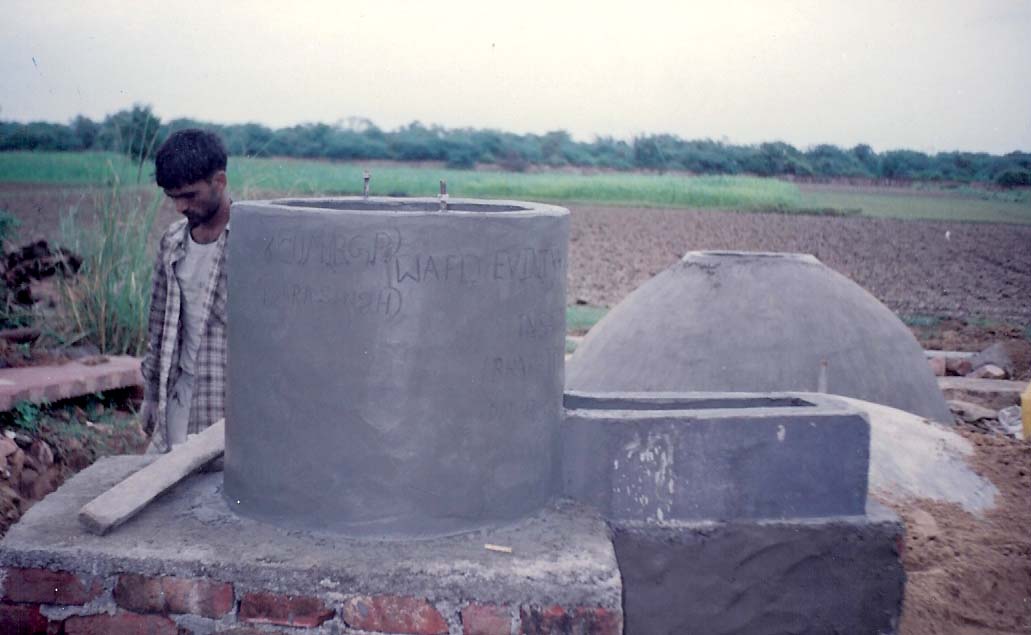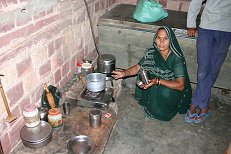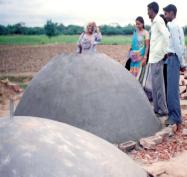| About Us | Contact Us | Contact Database | Support Us |
- MANUAL-
3.1.2.
Biogas
Biogas plant is an airtight container that facilitates fermentation of material under anaerobic condition. Other names given to this device are ‘Biogas Digester’, ‘Biogas Reactor’, ‘Methane Generator’ and ‘Methane Reactor’. Recycling and treatment of organic wastes (biodegradable material) through anaerobic digestion (fermentation) technology not only provides biogas as a clean and convenient fuel but also an excellent and enriched bio-manure.
Thus the BGP also acts as
mini bio-fertilizer factory; hence some people refer it as ‘Biogas fertilizer plant’ or ‘Bio-manure
plant’. For example, in a semi-continuous BGP, the fresh organic
material (in homogenous slurry form) is fed into the plant from one end
known as ‘inlet pipe’ or ‘inlet tank’. Decomposition
(fermentation) takes place inside the digester as a result of bacterial
(microbial) action, which produces biogas and organic fertilizer (manure)
rich in humus and other nutrients. There is a provision for storing biogas
on the upper portion of the BGP. Some BGP designs have floating gasholder
while others have fixed gas storage chamber. On the other end of the
digester ‘outlet pipe’ or ‘outlet tank’ is provided
for the automatic discharge of the liquid digested manure.

Domestic biogas plants installed in India and other South Asian countries use bovine (cattle or/and buffalo) dung mixed with equal quantity of water to maintain 8- 12% (average 10%) total solids (TS) concentration in the influent slurry. Whereas, the effluent has 9.5- 9.75% TS (average) discharged from the plants is, in general, collected into the slurry pits or spread onto the ground for drying before transportation to fields for use as organic manure.
 Anaerobic
digestion of organic matter produces a mixture of methane (CH4)
and carbon dioxide (CO2) gas that can be used as a fuel for cooking,
lighting, mechanical power and the generation of electricity, or a replacement
for other fuels. Waste from the kitchen, human and animal waste, indigenous
plants or residues from agriculture crops can be used for the production
of biogas.
Anaerobic
digestion of organic matter produces a mixture of methane (CH4)
and carbon dioxide (CO2) gas that can be used as a fuel for cooking,
lighting, mechanical power and the generation of electricity, or a replacement
for other fuels. Waste from the kitchen, human and animal waste, indigenous
plants or residues from agriculture crops can be used for the production
of biogas.
Applications:
- Replacement of firewood as the main fuel for cooking. It may also be used for direct lighting using especially designed biogas lamps, where there is no electricity.
- Generation of electricity using internal combustion engines or gas turbines.
Advantages:
- As a replacement for firewood the biogas reduces pressure on forests, and can aid to re-forestation projects.
- Biogas provides safe and environmentally sound way to dispose off a variety of organic wastes, thereby improving local health and sanitation.
- Solid residues from biogas production can be used in compost making.
Disadvantages:
- The system (especially batch-fed digesters) must be maintained and cleaned regularly with periodic removal of solid residues.
- Usual safety precautions must be observed for any gas distribution system.
A household digester unit or family size biogas plant normally has the gas production capacity to meet all the cooking and 2-4 hours of lighting (using biogas lamps with single mental) needs of a family. In India 1 m3 biogas plant refers to the rated capacity of that particular unit which has been designed to produce 1 m3, 1000 lt. or 35 ft3 gas per day under optimal conditions.
SL. No |
Plant Capacity |
Av. Daily Fresh Bovine Dung
and Slurry (ratio of 1 Kg. Dung :1 Lt. Water) Requirement |
Approx. No. of Av. Size
Cattle |
No. of family members (cooking
and lighting requirement) |
Average cost as on Sept
1, 2006 |
||
Fresh dung |
Fresh Slurry |
||||||
(M3) |
(Ft3) |
(Kg) |
(Lt.) |
(Nos.) |
(Nos.) |
(Indian Rs.) |
|
(a) |
(b) |
(c) |
(d) |
(e) |
(f) |
(g) |
|
1 |
1 |
35 |
25 |
50 |
2-3 |
3-4 |
10000 |
2 |
2 |
70 |
50 |
100 |
4-6 |
6-8 |
12000 |
3 |
3 |
105 |
75 |
150 |
6-9 |
9-12 |
15000 |
4 |
4 |
140 |
100 |
200 |
8-12 |
12-16 |
18000 |
5 |
6 |
210 |
150 |
300 |
12-18 |
18-24 |
24000 |
Smallest size BGP having 1 m3 capacity can meet the cooking and lighting needs of generally a small family of 3-4 members. Whereas, the biggest family size of 6-m3 capacity plant can fully meet domestic needs of a comparatively large joint family (18-24 members).
Capacity rating of biogas plant- Indian Vs Chinese & International Terms It is very important to know how a biogas plant is rated in different
countries, other wise the confusion may arise among the practitioners
and implementers of biogas technologies, especially for new people
entering in to this field. This aspect is clarified further in the
subsequent paragraphs, by giving examples of two main countries (India
and China) involved in the promotion and implementation of simple
household biogas models, especially for rural applications. |
Components of a simple household biogas plant (BGP)
Indian Semi-continuous-flow hydraulic digester household biogas plants are the most popular and common biogas plants built in rural India, which are floating gasholder model (KVIC) and fixed dome model (e.g. Janata and Deenbandhu model). So, the major components of only SCFHD biogas plants are: (i) Digester, (ii) Gas-holder or Gas storage chamber, (iii) Inlet, (iv) Outlet, (v) Mixing tank, and (vi) Gas outlet pipe.
Classification of Biogas Plants (BGPs)
1. Floating
Gas Holder Biogas Plant:
This is one of the common designs in India and comes under the category
of semi-continuous-fed plant. It has a cylindrical shaped floating biogas
holder on top of the well-shaped digester. As the biogas is produced
in the digester, it rises vertically and gets accumulated and stored
in the biogas holder at a constant pressure of 8-10 cm of water column.
The biogas holder is normally designed to store 50% of the daily gas
production.
2. Fixed
Dome Biogas Plant:
 The plants based on ‘Fixed Dome’ concept was developed in
India in the middle of 1970 after a team of officers visited China. The
Chinese fixed dome plants use seasonal crop wastes as the major feedstock
for feeding; therefore, their design is based on principle of ‘semi-batch-fed
digester’. The Indian fixed dome plant designs use the principle
of displacement of slurry inside the digester for storage of biogas in
the fixed ‘Gas Storage Chamber’. Indian fixed dome BGPs are
designed for pressure inside the plant varying from a minimum of 0 to
a maximum of 90 cm of water column. The discharge opening is located
on outer wall surface of the outlet displacement chamber and it spontaneously
controls the maximum pressure.
The plants based on ‘Fixed Dome’ concept was developed in
India in the middle of 1970 after a team of officers visited China. The
Chinese fixed dome plants use seasonal crop wastes as the major feedstock
for feeding; therefore, their design is based on principle of ‘semi-batch-fed
digester’. The Indian fixed dome plant designs use the principle
of displacement of slurry inside the digester for storage of biogas in
the fixed ‘Gas Storage Chamber’. Indian fixed dome BGPs are
designed for pressure inside the plant varying from a minimum of 0 to
a maximum of 90 cm of water column. The discharge opening is located
on outer wall surface of the outlet displacement chamber and it spontaneously
controls the maximum pressure.
3. Flexible
Bag Biogas Plant:
Main Unit of the Plant (MUP) including the digester is fabricated by
using rubber, high strength plastic, neoprene or red mud plastic. The
inlet and outlet are made of heavy duty PVC tube. A small pipe of same
PVC tube is fixed on top of the plant as Gas Outlet Pipe. Flexible bag
biogas plant is portable and can easily be erected. It requires support
from outside, up to the slurry level, to maintain the shape as per its
design configuration, which is done by placing the bag inside a pit dug
on site. The depth of the pit should in proportion to height of the digester
so that the mark of the initial slurry level is in line with the ground
level. The outlet pipe is fixed in such a way that its outlet opening
is also in line with the ground level. Some weight has to be added on
the top of the bag to build the desired pressure to convey the generated
gas to the point of utilization. Advantage of flexible bag plant is that
the fabrication can be centralized for mass production. Individuals or
agencies having land and basic infrastructure can take up fabrication
of this BGP with small investment after some training. However, as the
cost of good quality plastic and rubber is high. Moreover, the working
life of this plant is also much less compared to other Indian household
BGPs.
There are other plants available in India but are not very popular as
Tunnel Shaped Biogas Plant and Split Design Biogas Plant (With Separate
Gas Holder).


